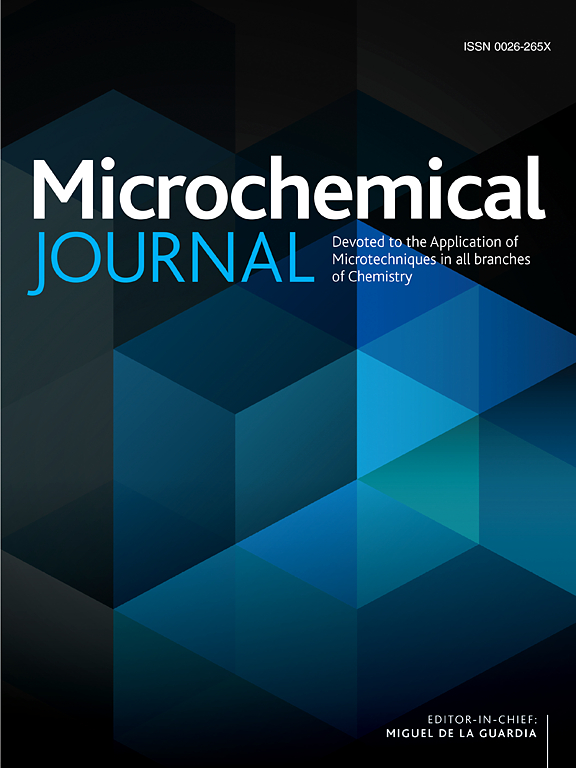Dual-mode lateral flow immunoassay for rapid profiling of tetrabromobisphenol A bis(2-hydroxyethyl) ether
IF 4.9
2区 化学
Q1 CHEMISTRY, ANALYTICAL
引用次数: 0
Abstract
Developing high-performance lateral flow immunoassays (LFIA) for portable and rapid profiling equipment is a key to meet the field-testing of hazardous pollutants. Tetrabromobisphenol A bis (2-hydroxyethyl) ether (TBBPA-BHEE) as an emerging hazardous contaminant poses potential risks to human health, yet there is no rapid, specific or sensitive LFIA for monitoring purpose. Herein, a novel dual-mode LFIA for field testing TBBPA-BHEE was pioneered with colorimetric/diffuse reflection using gold nanoflowers (AuNFs) and monoclonal antibody (AuNFs@mAb). Initially, a functional monoclonal antibody (mAb) was prepared and purified. The mAb was subsequently labeled on AuNFs to create the AuNFs@mAb probe, which could be captured by TBBPA-BHEE molecule in 10 min and achieved colorimetric/diffuse reflectance spectroscopy using naked eyes or portable immunochromato-reader, respectively. The preparation of test strips was systematically studied and the LFIA for qualitative and quantitative analysis of TBBPA-BHEE were evaluated. The optimized LFIA achieved a visual limit of detection (LOD) of 5.0 ng/mL and a detection LOD of 0.25 ng/mL by portable immunochromato-reader. It showed a high specificity for TBBPA-BHEE, good recovery yields of 112.41–120.10 % with the relative standard deviation (RSD) less than 8.0 %, and excellent long-term stability. Moreover, the results of the resultant LFIA were highly consistent with that of HPLC method, with a correlation coefficient of 0.995. Therefore, this study highlights the promising application in developing an economical and selective LFIA to field profiling of TBBPA-BHEE.

双模式横向流动免疫分析法快速分析四溴双酚A双(2-羟乙基)醚
开发便携式和快速分析设备的高性能横向流动免疫测定(LFIA)是满足有害污染物现场测试的关键。四溴双酚A双(2-羟乙基)醚(TBBPA-BHEE)是一种新兴的有害污染物,对人类健康具有潜在的风险,但目前还没有快速、特异或敏感的LFIA用于监测。本文采用比色/漫反射技术,利用金纳米花(AuNFs)和单克隆抗体(AuNFs@mAb),开创了一种用于现场测试TBBPA-BHEE的新型双模LFIA。首先制备并纯化一种功能性单克隆抗体(mAb)。随后将单抗标记在aunf上,形成AuNFs@mAb探针,该探针可在10分钟内被TBBPA-BHEE分子捕获,并分别使用肉眼或便携式免疫色谱仪进行比色/漫反射光谱分析。对试纸条的制备进行了系统的研究,并对TBBPA-BHEE定性和定量分析的LFIA进行了评价。优化后的LFIA的视觉检出限为5.0 ng/mL,便携式免疫层析仪的检出限为0.25 ng/mL。该方法对TBBPA-BHEE特异性高,回收率为112.41 ~ 120.10%,相对标准偏差(RSD)小于8.0%,长期稳定性好。所得结果与HPLC法高度一致,相关系数为0.995。因此,本研究强调了开发一种经济、选择性的LFIA在TBBPA-BHEE现场分析中的应用前景。
本文章由计算机程序翻译,如有差异,请以英文原文为准。
求助全文
约1分钟内获得全文
求助全文
来源期刊

Microchemical Journal
化学-分析化学
CiteScore
8.70
自引率
8.30%
发文量
1131
审稿时长
1.9 months
期刊介绍:
The Microchemical Journal is a peer reviewed journal devoted to all aspects and phases of analytical chemistry and chemical analysis. The Microchemical Journal publishes articles which are at the forefront of modern analytical chemistry and cover innovations in the techniques to the finest possible limits. This includes fundamental aspects, instrumentation, new developments, innovative and novel methods and applications including environmental and clinical field.
Traditional classical analytical methods such as spectrophotometry and titrimetry as well as established instrumentation methods such as flame and graphite furnace atomic absorption spectrometry, gas chromatography, and modified glassy or carbon electrode electrochemical methods will be considered, provided they show significant improvements and novelty compared to the established methods.
 求助内容:
求助内容: 应助结果提醒方式:
应助结果提醒方式:


